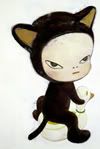Yesterday Jon and I went to a free talk at SLAC (Stanford Linear Accelerator Center) about lasers. We biked up Sand Hill road and it felt like dying (Biking is perhaps the only activity in which "downhill" has a happy connotation). Before going to the talk we had a celebratory dinner at the Treehouse for my employment at a product design firm (WOOOOOT. I got a job. Sweet Jesus I found a job). I will be working as a design/engineering intern for Compass Product Design up in Pleasanton. The ordeal of getting to the actual firm for the job interview is worthy of a blog entry but I'll just skip over most of that. So the bike up to SLAC was tiresome but the scenery was quaint. Palo Alto really is a great city for bikers.
Jon showed me his office. On our way there, there were three very scrawny, very geeky looking middle aged scientists playing Frisbee on the grounds. They look really excited and happy. This place looked like a haven for nerds! When we reached his building (A&E) there was a sphere concrete "sculpture" with a very crudely painted smiley face on it. It looked rather strange. Like some neanderthal had plopped it there and certainly possessed a quality so starkly different from all the other sleek looking "modern" sculptures smattered across the campus. I told him that SLAC looked and smelled like Caltech. And by Caltech I mean despair.
The talk was sufficiently water down lecture on optics and lasers. I still didnt quite understand most of it, but lasers are brighter than the sun! Also you cannot magnify the intensity of a light source using lenses. The best you can do is actaully just replicate the intensity of the source. For instance, during the process of burning an ant using a lens, while you are still gathering the brightness and heat of the sun, you are not magnifying it. In fact supposedly you can calculate this using math. But who needs that really? Finally, the speaker started talking about his own research and being able to create the ultimate intense light source using the Linear Accelerator and a 2 mile long string of laser beams using short pulses as a way of magnifying their intensities. He says that they could get it to be so bright that the photons will actually destroy each other!
This inspired Jon to come up with theory to explain something in science fiction. Supposedly if something and its anti-thing will collide, they will cancel each other out. For instance, an electron and a positron will cancel each other and become a new particle (?) maybe? Or maybe just annihilate each other. This is why if you can travel back in time you should never touch your you-of-the-past. Because an anti-thing is just something that is travelling back in time, and a thing is something going forward in time. When you collide with your past self, you will just simply.. self-destruct.
Thats enough pop science for today my dearies.
29.6.05
Super intense lasers and employment
at 11:24 AM
